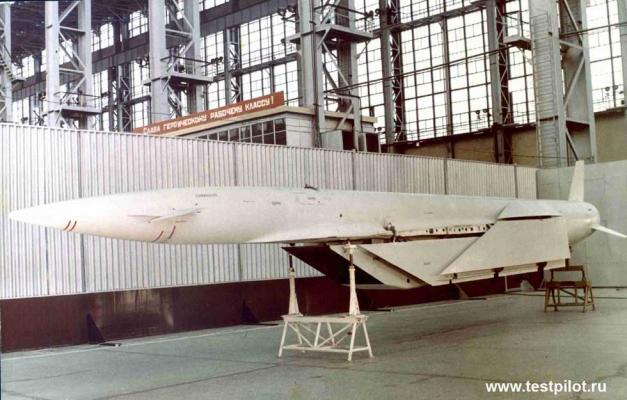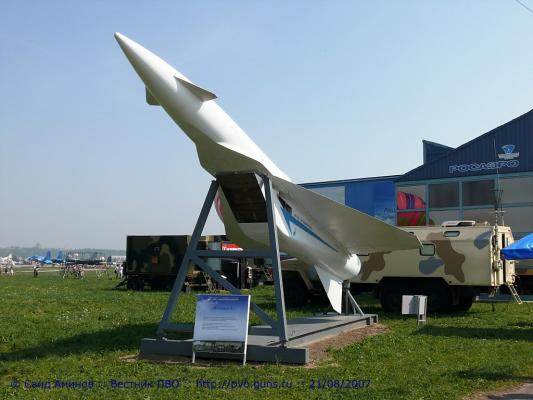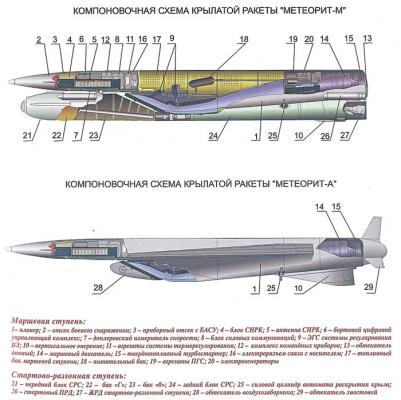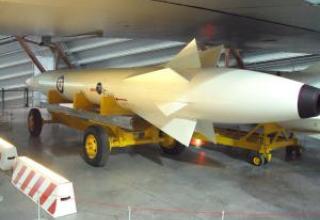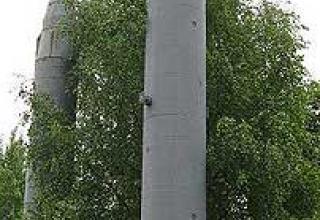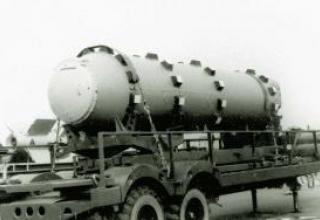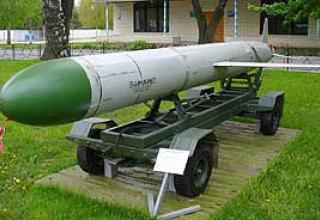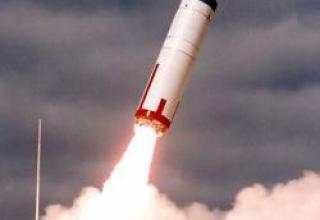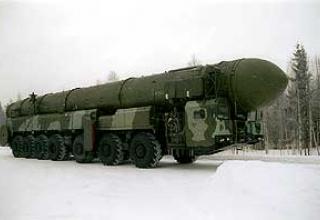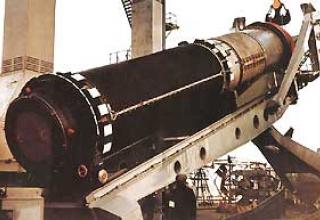December 9, 1976 was issued the Decree of the USSR CM on the development of a universal strategic supersonic cruise missile 3M-25 "Meteorite" with a range of about 5000 km. The missile was to be launched from ground-based launchers ("Meteorit-N"), nuclear submarines ("Meteorit-M") and strategic bombers Tu-95 ("Meteorit-A"). The main developer was the Central Design Bureau of Machine Building (later on, NPO Mashinostroitelstvo, chief designer V.N.Chelomey).
Initially, as a carrier for the marine version of the "Meteorit-M" was supposed to use agroindustrial complex pr. Initially it was planned to use as a carrier for the marine version of "Meteorite-M" the agroindustrial complex at 949 Ave. However, design studies carried out by the Central Design Bureau of MT "Rubin" showed that in order to place KR 3M-25 on the launch unit of PKRK "Granit" it is necessary to radically change the design of the latter, and in order to place the second set of control equipment for ship systems of daily and pre-start service (AU KSPPO) of the complex "Meteorite" it is necessary to increase the length of the complex by 5-7 meters. Attempts to create a unified AU KSPPO for complexes "Granit" and "Meteorite" were not successful.
At the suggestion of LPMB "Rubin" it was decided to re-equip under "Meteorit-M" one of RPK SN Pr.667A, withdrawn from the strategic forces under the contract OSV-1, meaning not only to conduct tests on this submarine, but also the subsequent operation of the boat as a combat unit. The K-420 submarine was singled out for re-equipment, on which the missile compartments were cut out and related repairs were made. Sevmashpredpriyatiye (General Director G.L. Prosyankin) was appointed as the builder. The Rubin LPMB developed the technical project of re-equipment of the submarine pr.667A for the Meteorit-M missile system (project 667M, cipher "Andromeda") in the 1st quarter of 1979. The development of the Meteorit-M launcher, which was placed on the 667M project submarine and designated SM-290, was carried out by the Special Machine Building Design Bureau (Leningrad). The launch unit SM-290 passed all kinds of tests and was put into pilot operation in the Navy in the early 80's.
The works on PL conversion and repair were carried out by Sevmashpredpriyatiye at an extremely fast pace. Missiles were developed by launching from the ground stand (Kapustin Yar range) and floating stand of the SSC in the Black Sea in parallel with the ship's conversion. The first launch of Meteorite took place on May 20, 1980. The rocket did not leave the container and partially destroyed it. The following three launches were also unsuccessful. Only on December 16, 1981, the rocket flew about 50 km. A total of more than 30 launches of ZM-25 missiles were made from the stands in 1982-1987 under the flight and design testing program. The first launch of Meteorite-M from K-420 took place on December 26, 1983 in the Barents Sea, the tests continued until 1986 inclusive (one launch in 1984 and one launch in 1986).
There were several reasons for such a long development of the complex, but perhaps the main one was a large number of fundamentally new technical solutions adopted in the project: "wet" underwater launch of the cruise missile under the upper stage, inertial guidance system with correction on radar maps, multifunctional protection complex, etc. All these progressive solutions required thorough experimental testing, which led to repeated repeated tests and, consequently, to numerous postponements of delivery dates. As a result, joint (state) tests of Meteorit-M complex started only in 1988, first from the ground stand (4 launches) and then from the PL (3 launches). Unfortunately, the number of successful launches at all stages of testing approximately corresponded to the number of unsuccessful launches, as the complex was still not brought to "mind". In addition, the cost of retrofitting the RSSCN project 667 to the Meteorit-M complex, which is being withdrawn under the OSV-1 contract, was too high. As a result, under the joint decision of industry and the Navy, work on the program was stopped in late 1989. The ship's part of the complex was transferred to the responsible storage of the PL personnel, and the boat itself was delivered to the fleet in 1990 in a torpedo version.
For the development of aviation-based complex at the Taganrog Aviation Plant (now JSC "TAVIA") on the basis of a serial missile carrier Tu-95MS ¹04 was prepared by a special aircraft carrier, designated Tu-95MA. Two CR "Meteorite A" were placed on special pylons under the wing, which left a free bomb compartment. In it, within the agreed loads, it was possible to place the ICU with 6 radar missiles X-15P. Testing of "product 255" at the range began in 1983. During the flight tests were carried out 20 launches from the aircraft Tu-95MA. The first launch from the Tu-95MA January 11, 1984 was unsuccessful. The rocket flew quite "in the wrong steppe" and at 61st second was self-liquidated. In the next air launch with the Tu-95MA, held May 24, 1984, the rocket again had to eliminate. However, a large program of flight tests allowed to practically bring the missile. Tests of ultra-long-range missile has set a number of new tasks for the technical management. The route range of the Kapustin Yar test site was insufficient. On the flight path from the Volga to Balkhash (the route Groshevo-Turgai-Terekhta-Makat-Sagiz-Emba) it was necessary to perform a very exotic (for a rocket with such a speed) 180° turnaround manoeuvre.
Two S-200 anti-aircraft missile systems were also launched for the purpose of evaluating the missile's air defense capabilities.
Here is how this test is described in the book "The Bright Trace of the Crystal Meteorite":
"At a given time, a multifunction defense system was activated. After the registration of the radiation of the ground radar and the signal "Detection" on command from the MFKZ was involved a special installation, which due to failure failed to enter operating mode. The missile was demasked. The newest air defense missile (S-200) was launched two missiles: the first in telemetry mode, the second - in combat. At known times and trajectories of the flight Meteorite missile was destroyed only by fragments of the combat unit of the second anti-missile. Due to the use of only one installed false target, the first missile turned away from the LC".
When testing the aircraft version of the missile ("Meteorite A") Tu-95MA plane with a rocket on the outer suspension rose from one of the airfields near Moscow, went to the launch zone of the SCR, performed the launch and returned. The missile carried out a flight along a closed route several thousand kilometers long. Test results confirmed the technical possibility of creating different types of base complexes with a further strategic RCDS.
In addition to the strategic sea-based and air-based missile systems, the Machine-Building Research and Production Association was working on other applications of the Meteorite missile. Among them: a reconnaissance and strike system with a mobile ground- and sea-based Meteorit-P cruise missile, as well as an ultra-long-range air-to-air target interceptor equipped with guided missiles. "air-to-air".
The 3M-25 missile was not deployed on land-based and airborne launchers, as under the international treaty, medium- and short-range ground-based and airborne missiles were to be destroyed.
In the west, the Meteorit-M complex was designated SS-N-24 "Scorpion", "Meteorit-N" - SSC-X-5, "Meteorit-A" - AS-X-19.
Composition:
The Meteorite rocket was made according to the aerodynamic scheme "duck" with a folding arrow-shaped wing and folding vertical plumage. The missile had a flight speed of 3500 km/h and a range of about 5000 km. Its flight altitude was 22-24 km.
The KR-23 turbojet engine is capable of operating in a wide range of flight conditions: speed from 0.4 to 3M and flight height from 0 to 24 km. The KR-23 (see photo) was developed by the Design Bureau of the Ufa Engine Building Association. The air intake of the marching engine is placed at the bottom of the fuselage (see photo).
The fuel system of the marching stage was equipped with a 2800-liter fuel tank divided into five sections, which made it possible to keep the missile aligned as the fuel was produced. The tank had a two-stage supercharging system. During the flight at high altitudes, the fuel and RC temperatures generally dropped below minus 50 degrees, which caused problems with the launch of the TRD. To overcome this situation, an additional heated starting fuel tank with five liters capacity was introduced into the system, which ensured reliable engine start. KR-23 used a combined automatic electronic-hydraulic control system, which included an electronic analogue regulator R-93A and a fuel pump regulator HP-93A, which had a redundancy channel to provide the engine with fuel in case of failure of the main system.
The high specific flow rate at the motor inlet, taking into account the required mass and dimensions, has led to the need for new technical solutions in the design of TRD. The result is a compact combustion chamber with a normal temperature field. When transonic speeds were encountered during the tests, successful design solutions allowed the engine to be boosted without changing its design. Increased traction was achieved by the gas generator and increased engine speed due to the absence of an afterburner, as well as by increasing the gas temperature in front of the turbine. Another unique technical solution was the TRD start system with the help of a solid fuel starter. The designers put in a rigid weight frame were able to implement the technology of a solid fuel starter, which in eight to ten seconds outputs 80 percent of the engine power.
Achieving low radar visibility was key to improving the missile's air defense breakthrough capabilities. A new special electronic installation, which had no analogues in the world, was created. Its principle of operation was based on the effect of external electromagnetic radiation absorption. The results of scientific developments and experiments on spacecraft camouflage at altitudes above 100 km were used to create the electronic system. Such experiments were conducted by the Central Design Bureau and the Thermal Process Research Institute (now the Keldysh Research Centre). However, the creation of on-board electronic system for masking a relatively large aircraft, which was a cruise missile flying at an altitude of 20-25 km, was a completely new and complex task. Even research and development work had not been carried out in this area before. Calculations showed that the electronic installation would have a high power consumption and high voltage at the executive bodies. This created additional complexity under the conditions of limited onboard power supplies to the cruise missile and the need to ensure electromagnetic compatibility of the special electronic system with other radio electronic systems.
The development of the electronic unit was carried out by the Research Institute of Thermal Processes under the guidance of Vitaly Ievlev, corresponding member of the USSR Academy of Sciences. The unit was created and passed a full range of bench and field flight tests. During the flight tests of Meteorite missile when switching on the electronic unit on the indicators of the air defense radar there was observed a decrease in the brightness of the target mark, unstable tracking and loss of mark.
Reduced radar visibility of the missile was also due to the elimination of sharp surface breaks, large sweeps of wings and stabilizers, the widespread use of radio-absorbing materials and coatings, the use of inside the air intake channel of the engine special reflective grating. The use of radio-absorbing materials and coatings, as well as a special electronic unit provided a reduction in the effective scattering surface (EPR) of the missile by two to three orders of magnitude, depending on the wavelength of the irradiating radar. To reduce the missile's visibility in the infrared range of the radiation spectrum, a special nozzle was installed on the nozzle of the marching engine, which provided shielding of infrared radiation from the flare.
The missile was equipped with an on-board radiotechnical protection system, which included a broadband receiver of signals from operating enemy radars, an Active Interference Station (ALS) and towed false targets. In the course of the flight, depending on the radar situation and the threat from the air defense firing means, a special electronic system was to be switched on, SAP and towed false targets were to be used. For the first time, towed decoys were mounted on a supersonic cruise missile. It was necessary to solve the problems associated with the separation and deployment of a towing rope about 100 m long at supersonic speed.
Another fundamentally new system created for the Meteorite missile was the navigation system on radar maps (SNRC "Kadr"). This system was to work in conjunction with the missile's inertial control system and to periodically correct the missile's flight path by comparing the radar image observed in flight with the reference image available on board. The difficulty in creating such a system was due to the variability in the ground reflection characteristics in different seasonal and weather conditions. The SNRC "Kadr" was created and successfully tested. The main designer of the missile control system was the Elektropribor Design Bureau (Chief Designer Vladimir Sergeev), and the correction system was the Research Institute of Precision Instruments (Chief Designer Yuri Kozko).
The ZM-25 ("Meteorit-M") submarine missile was equipped with a special upper stage with two liquid rocket engines RD0242 with rotary nozzles (see photo). The RD0242 engine with the thrust of 12t of the closed circuit with afterburning of the oxidizing gas-generator gas was developed by KBHA (Voronezh Chemical Automation Design Bureau) in the period 1977-1988. The operating time of the starting and accelerating stage engines was 32 seconds. The launch weight of the rocket was 12650 kg (6380 kg without accelerator). The air version of Meteorite A had a solid fuel accelerator in its tail end.
The project of re-equipment of the submarine Prospect 667A for the Meteorit-M missile system (project 667M, cipher Andromeda) provided for the placement of 12 launch containers with 3M-25 missiles, located in the intercombined space at an angle of 45°. The significant size of the missile containers had a significant impact on the architectural and structural appearance of the PLARC. In the area of missile containers (on sides in the middle part of the PL) the width of the outer hull was increased from 11.7m to 15.0m. The diameter of the strong hull in this area, on the contrary, was reduced in comparison with the diameter of the dismantled missile compartments. The length of the ship was increased by 20m. In the new 4 and 5 compartments the equipment of prelaunch preparation and launch "Clover", AU KSPPO "Korshun-44", pneumatic-hydraulic systems KSPPO, and in the third (5-bis) - residential and public premises for the crew were placed. Some reconfiguration was carried out at the central post in connection with the installation of a new control system for the missile weapon system, a new navigation system "Tobol-AT", a complex of radio communication facilities "Lightning-LM1" and hydroacoustic complex "Rubicon". In order to keep the boat in the launch corridor in volley fire, the Bor control system was installed.
KR 3M-25 was stored in a container PL with folded fender consoles and sealed marching engine. It could be launched from a depth of 40m and with a carrier speed of up to 10 knots. Before starting, the container was filled with water and to open the lid, the water pressure in the container was compared with that of the outboard. At the same time, the missile itself was inflated (to avoid deformation). The booster stage brought the missile to the surface and was separated from the missile after reaching the specified flight speed and starting the marching engine.
The SM-290 launcher equipment (see diagram) is mounted in a container with a lid and drives. Inside the container there is a fixation mechanism, front, middle and lower locks (providing stable position of the missile in the PU during its operation) and guides. The guides are made by extrusion method with minimal allowances on the working surfaces of high-strength corrosion-resistant steels. The sections of the guides located in the areas of the boots of the loaded missile, are made in elastic version and provide reduction of transverse overloads coming to the missile, to admissible values. On the flange of the fixation mechanism is installed suspension fork transition mobile additional (VPPD) with pneumatic valves, which provides docking (unhooking) VPPD and pneumatic valves during the loading and launch of the missile. In the niche of the container is a mechanism for pulling back the electrical plug, which pulls and holds the board during the launch of the rocket. The front release mechanism is fixed on the lid of the container and is led to the upper support belt of the rocket after its loading into the PU when the lid is closed. The shock absorbers of the front buckle are made in the form of double-acting torsions. Before starting the missile when the lid is opened, the front buckle is removed from the missile. The supply of working fluid (PGV) to the actuators is carried out from the ASG PL through the hydraulic manipulator or through the reserve pipeline from the PU pumping station from the LIP. In all operating modes of PU SM-290 the control of mechanisms is remote. The PU provides the possibility to cancel the start at any stage of pre-start preparation. Failure of one or several PU does not impose restrictions on the operation of other PU.
Characteristics:
| Maximum firing range, km | 5000 |
| Maximum flight speed, km/h. | 3500 |
| Flight altitude, km | 22-24 |
| Starter mass: - booster - unaccelerated |
12650 6380 |
| Dimensions, m: - length, m - wingspan, m - wing area, sq.m. |
12,5-13 5,1 22 |
| Weight BC, kg | 1000 |
Testing:
MTUR "Malyutka" was very successfully used during the Arab-Israeli War in 1973, it was with its help that almost the entire Israeli tank fleet was destroyed - about 800 vehicles. Only on October 6, 1973, for example, the 252nd Israeli Tank Division was defeated - more than a hundred vehicles were hit.
Sources:
- А.В.Карпенко Крылатая ракета «Гром» /«Бастион» /
- "КБ специального машиностроения: От артиллерийских систем до стартовых комплексов" (под редакцией Ушакова В.С.) .СПб, 2004.
- 3М-25 Метеорит (П-750)
- ПЛАРК - Проект 667М "Андромеда" /Российский подводный флот/
- 3М-25А Метеорит-А стратегическая универсальная ракета
